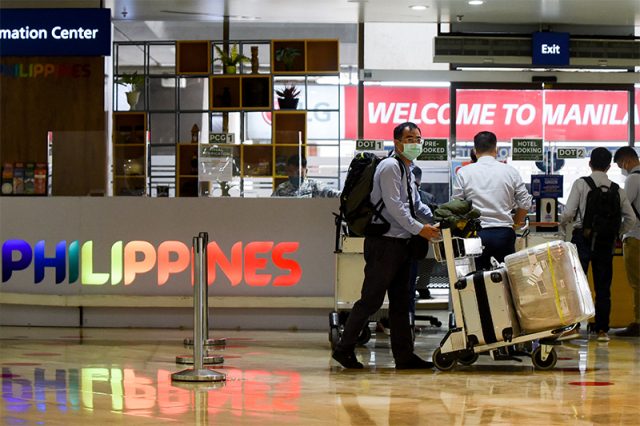
Some Filipinos raised that the symptoms of monkeypox might appear in different parts of the body following a report about how airport officials screen possible cases.
On Tuesday, ABS-CBN reporter Jacque Manabat shared videos that showed the thermal and visual check as part of the screening procedure for arriving passengers at the Ninoy Aquino International Airport.
In one video, airport staff asked an arriving passenger to roll up her sleeves to check for quick health safety assessment and inspection of any skin rashes or lesions on her hands and arms.
Passengers still go through a thermal scanner before being allowed to enter the airport.
“Incoming passengers from an international flight are asked to roll up their sleeves upon arriving at NAIA. Aside from body temperature, the Bureau of Quarantine checks any skin rash on hands or arms,” Manabat said in her tweet.
LOOK: Incoming passengers from an international flight are asked to roll up their sleeves upon arriving at NAIA. Aside from body temperature, Bureau of Quarantine checks any skin rash on hands or arms.
Fever and skin lessions are some of monkeypox virus symptoms. pic.twitter.com/8spnNXWB9A
— Jacque Manabat (@jacquemanabat) August 2, 2022
The other videos showed the rest of NAIA’s current airport protocols amid the still raging COVID-19 pandemic.
Passengers have to present their vaccination cards that indicated they are fully inoculated and boosted. They also have to present the One Health Pass QR Code.
Those with incomplete vaccine shots, meanwhile, should present a negative RT-PCR test result taken 48 hours before the flight.
They may also present a negative antigen test result that was taken 24 hours before the flight.
In a separate report, the roll-up sleeve step when entering the NAIA gates is an additional health safety check that the Bureau of Quarantine recently started implementing in response to the monkeypox outbreaks overseas.
NAIA quarantine medical officer Rhaychelle La Rosa said that a medical officer will determine if a passenger requires a secondary screening.
“Pinapataas natin ang jackets hanggang maaari makita natin iyong signs and symptoms. We will have primary screening using the thermal scanner if the medical officer sees that this person needs to be evaluated further we do a secondary screening,” La Rosa was quoted in the report as saying.
The BOQ, however, admitted that this additional measure might not be enough to prevent monkeypox entry into the country.
The bureau advised additional tests to be conducted to further confirm if a person is infected with the contagious disease.
If confirmed, BOQ will trace and reach out to the infected person’s close contacts to determine if they are also experiencing similar symptoms.
‘Symptoms also appear in other body parts’
The airport’s visual check on the arms and hands was met with criticisms on Twitter.
They pointed out that rashes and lesions can also appear on other body parts such as legs and feet.
“Seriously? Mema? What if the lesions aren’t there? Parang mga sekyu lang sila sa mall?” forensic scientist Raquel Fortun said.
“Performative… Paano kung nasa legs? It’s giving tusok sa bag ng security guard,” one user remarked.
“Pano kung nasa singit ang rash or sores?” another user asked.
One Twitter user also said that such an assessment might bring trouble to people with psoriasis.
“High temp and skin lesions? Ayoko na pala lumabas, baka madetain ako bilang isang hot momma with psoriasis,” the user tweeted.
Psoriasis is a skin disease characterized by rashes with itchy, scaly patches. They are most visible on the knees, the elbows, the scalp and the body.
Recalling monkeypox symptoms
Monkeypox, meanwhile, causes rashes on the face, palms and soles of the feet. These rashes may also develop lesions.
READ: Monkeypox symptoms to monitor, according to DOH
The United States Centers for Disease Control and Prevention also said that rashes can appear “on or near the genitals (penis, testicles, labia, and vagina) or anus (butthole).”
Other symptoms include:
- Fever
- Headache
- Muscle aches and backache
- Swollen lymph nodes
- Chills
- Exhaustion
- Respiratory symptoms (e.g. sore throat, nasal congestion, or cough)
The World Health Organization recently declared monkeypox a public health emergency of international concern or global health emergency amid the rapid rise of cases in many countries.
Despite this high alert, the national government has yet to issue a ban on any country with a reported monkeypox case.
The Philippines detected its first case last Friday. He is a citizen who returned from abroad.









